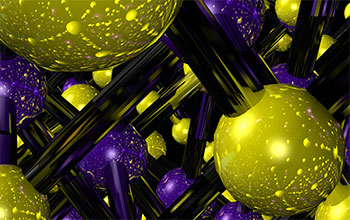Multimedia Gallery
Going nano: big innovations at small scales
At The University of Texas at Austin, researchers are applying nanotechnology to develop new uses for molybdenum disulphide (MoS2), a compound used as a lubricant and in petroleum refining. This computer-generated image shows a close-up view of MoS2 after it was placed in a diamond anvil cell with electrical currents to see if it could create a new material. Running electric leads through the structure, researchers can trigger electronic transitions and manipulate the mechanical, electrical and optical properties of this innovative-layered nanomaterial. The image has been rendered with the perspective of one of the atoms inside the environment. The complex structure of the stacked assembly is visible in the highly reflective surface of the molecules.
More about this image
Scientists are looking to nanotechnology for the next big breakthroughs. Nanotechnology offers enormous, new opportunities for innovation in materials science, electronics, medicine and more. Computational resources are critical to advancing this burgeoning field.
The visualization was produced using the Texas Advanced Supercomputing Center's (TACC) Stampede computing system. Stampede is funded by the National Science Foundation through award ACI 11-34872.
Read more about this research in the story Pressure-induced semiconducting to metallic transition in multilayered molybdenum disulphide. (Date of Image: 2013-2014)
Credit: Visualization Interfaces and Applications: Joanna K. Wozniak, Texas Advanced Computing Center, The University of Texas (UT) at Austin; Research Team: Avinash P. Nayak, UT at Austin, Swastibrata Bhattacharyya, Indian Institute of Science, Jie Zhu, UT at Austin, Jin Liu, UT at Austin, Xiang Wu, UT at Austin, Tribhuwan Pandey, Indian Institute of Science, Changqing Jin, Chinese Academy of Sciences, Abhishek K. Singh, Indian Institute of Science, Deji Akinwande, UT at Austin, Jung-Fu Lin, UT at Austin
See other images like this on your iPhone or iPad download NSF Science Zone on the Apple App Store.
Images and other media in the National Science Foundation Multimedia Gallery are available for use in print and electronic material by NSF employees, members of the media, university staff, teachers and the general public. All media in the gallery are intended for personal, educational and nonprofit/non-commercial use only.
Images credited to the National Science Foundation, a federal agency, are in the public domain. The images were created by employees of the United States Government as part of their official duties or prepared by contractors as "works for hire" for NSF. You may freely use NSF-credited images and, at your discretion, credit NSF with a "Courtesy: National Science Foundation" notation.
Additional information about general usage can be found in Conditions.
Also Available:
Download the high-resolution JPG version of the image. (1.1 MB)
Use your mouse to right-click (Mac users may need to Ctrl-click) the link above and choose the option that will save the file or target to your computer.

